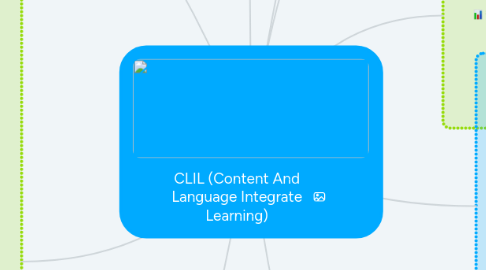
1. The 4Cs Framework
1.1. Communication
1.1.1. Means of expression, foreign language (for, of, through learning)
1.2. Culture
1.2.1. Cultural understanding and intercultural awareness
1.3. Cognition
1.3.1. Understanding process and meaning making as socially constructed
1.4. Content
1.4.1. Curricular subject or theme
2. Who is the CLIL teacher?
2.1. Planner
2.1.1. Teaching and learning and interconnected
2.2. Foreign language enthusiastic user
2.2.1. Interaction - motivation
2.3. Full - time pedagogue
2.3.1. Methodological innovator
2.4. Reflective professional
2.4.1. Experiences
2.5. Material designer
2.6. Evaluator and assessor
2.7. Team partnet
2.7.1. Interdisciplinarity
2.7.1.1. Negotiator
2.8. Not necessarily a languages teacher
2.8.1. Content learning with language teaching aims
2.9. Language usage constant promoter
2.9.1. Content through a language
2.9.1.1. Way of life
3. CLIL core principles for starting content driven lessons
3.1. Make
3.1.1. Learning active
3.2. Scaffold
3.2.1. Throughout the learning
3.3. Use
3.3.1. Visual organizers and aids throughout a lesson
3.4. Get
3.4.1. Support from other content and language teacher
3.5. Keep
3.5.1. In mind the 4Cs Framework
3.6. Use
3.6.1. Code switching if necessary
4. Differences between CLIL, CBI and EIM
4.1. CLIL
4.1.1. Integrated content + language competence
4.1.1.1. EIM: Subject knowledge acquisition
4.1.1.2. CBI: Language learning - learning subject is incidental
5. Content subject
5.1. Science, math, social studies, art...
6. Language Instruction
6.1. Additional Language
6.1.1. English, french, spanish...
7. Programs
7.1. Soft
7.1.1. Language - Strong subject content (geography, science...)
7.2. Hard
7.2.1. Curriculum areas - Second or additional language (language + content)
8. Language (communication)
8.1. For learning
8.1.1. How, linguistic system
8.1.1.1. It focuses on the language
8.2. Of learning
8.2.1. What, content
8.2.1.1. Analysis of the language - Basic concepts - Skills (subjects or topics)
8.3. Through learning
8.3.1. Why, cognition
8.3.1.1. Sociocultural principle - Involvement of language and thinking
9. Social Constructivism
9.1. Vygotsky's - Zone of proximal development
9.1.1. What a learner can do without assistance
9.1.2. What a learner can do with assistance
9.1.3. What a learner cannot do even with assistance
